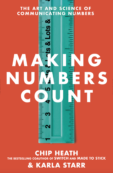We begin our book with the famous urban legend of the “kidney thieves.” If only it had stayed an urban legend. According to this article in the NYT, stealing kidneys has become a ghastly reality in one part of India.
A viral Christmas present
You may have seen “The Story of Stuff” by now — if you haven’t, it’s worth your time to check out. It’s an anti-consumerism video narrated by a woman named Annie Leonard. It’s been a huge viral sensation — it logged over 100,000 views in the week after its release.
The video is well done — it shows how a single voice and some simple graphics can tackle a very complex topic. I definitely have quibbles with the content of the video, but I admire it as a thoughtful, artful example of communication. And let’s just take a second to reflect on this rather unlikely success story, shall we?
This is a viral sensation that:
- Is 20 MINUTES LONG (I am not exaggerating)
- Has nothing lurid, sexy, embarrassing, disgusting, or funny in it
- Tackles big, macro, complex issues like production, distribution, consumption, etc.
- Will largely make you feel bad about yourself and your fellow humans
- Requires you to confront your own behavior through the lens of sustainability
This is indeed a Christmas gift to the world of ideas, and it’s a reminder to all of us that the right idea, communicated in the right way, can make a big difference.
Merry Christmas & Happy New Year to all of you, and thanks for the support you’ve given our book this year!
-dan & chip
Mercy Corps’s thoughtful use of concreteness
When you give to Mercy Corps, they follow up with an email that gives you a concrete vision of how you’ve helped. For instance: “Your support of $40 provides a Zimbabwean family clean drinking water for two years.”
Lots of charities have figured out that, in soliciting donations, they need to anchor abstract amounts of money in real-world descriptions (e.g., “Adopt a goat for $60,” “$200 pays for the translation expenses in a human-rights field visit,” etc.). I like how Mercy Corps uses the same principle after the fact. You get the initial satisfaction of giving, and then Mercy Corps follows up and says, effectively, “Thanks for your gift — and, by the way, a Zimbabwean family thanks you, too.” Nicely done.
“Canoe Man”
There are 6 principles of sticky ideas, and folks, Canoe Man has all 6. It’s no wonder why this bizarro tale has captivated the UK public.
Robert M brought it to our attention with this introduction: “Man vanishes at sea in 2002, only his battered kayak is found. Wife and two sons mourn, then wife claims life insurance 13 months later. Wife sells house and moves to Panama at the beginning of 2007. In Nov 2007 man walks into a police station, claiming to be the missing person who has lost his memory. Then, a photo turns up which shows man and wife in 2006 in Panama talking to a property developer. Sons are outraged because they were under the impression their father was dead.” And there’s more uncovered every day…
If someone doesn’t have the movie rights to this saga, I’m gonna make the first bid. In the meantime, go kill an hour and read up on the whole thing.
Triggers and water conservation
Park Howell saw our column about “Triggers” in Fast Company and wrote us with a great story:
In 1999, we created the “Water – Use it Wisely” conservation campaign that was completely built on environmental triggers. I think we were simply more intuitive (lucky) in our approach than brilliant (good) when creating the campaign, but it has stood the test of time and has grown to be the largest educational outreach for water conservation in the world. The campaign currently has more the 350 private and public partners using elements of the program.
The whole concept is based around surprising, but highly effective water-saving devices. Like a toothbrush, for instance. It is a physical prompt that reminds you to turn off the water while you brush your teeth (a razor does the same thing for shaving). The campaign is all about presenting these “water-saving devices,” each with it’s own number to emphasize the main campaign theme: “There are a number of ways to save water, and they all start with you.”
You can check out the campaign here.



